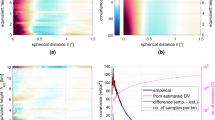Summary
Least squares collocation has been applied to global problems using a covariance function which is based on assumptions about the stochastic nature of the functions related to the earth' anomalous potential. The validity of the stochastic approach has been debated by different authors although its great practical advantages seem to be generally acknowledged. This paper discusses the possibility of using least squares collocation without assumptions on the stochastic nature of the functions involved. Different types of nonhomogeneous weight functions are derived and their characteristical features are pointed out. The suitability of this approach is demonstrated by computing harmonic coefficients from near resonant satellite orbits. A comparison of the homogeneous and a nonhomogeneous solution is given.
Similar content being viewed by others
References
L. AARDOM (1969): Some transformation properties for the coefficients in a spherical harmonics expansion of the earth's external gravitational potential, Tellus, 21, 4, pp. 572–583.
A.R. EDMONDS (1960): Angular Momentum in Quantum Mechanics, 2nd edition, Princeton.
E. GRAFAREND (1972): Nichtlineare Prädiktion. Zeitschrift für Vermessungswesen, 97, 6, pp. 245–255.
W.A. HEISKANEN, H. MORITZ (1967): Physical Geodesy, San Francisco.
W.M. KAULA (1967): Theory of Statistical Analysis of Data Distributed over a Sphere. Reviews of Geophysics, 5, 1, pp. 83–107.
H. KAUTZLEBEN (1970): Zur stochastischen Beschreibung eines skalaren Feldes auf der Kugeloberfläche, ÖZfV, Sonderh. 28, Festschrift Karl Ledersteger, Wien.
T. KRARUP (1969): A Contribution to the Mathematical Foundation of Physical Geodesy, Geodaetisk Institut, Meddelelse No. 44, Copenhagen.
S.L. LAURITZEN (1973): The Probabilistic Background of Some Statistical Methods in Physical Geodesy. Geodaetisk Institut, Meddelelse No. 48, Copenhagen.
H. MORITZ (1973): Least Squares Collocation. Deutsche Geodätische Kommission, Series A, No. 75, Munich.
A.M. OBUKHOV (1947): Statistically homogeneous random fields on a sphere. Uspeki Mat. Nauk, 2, 2, pp. 196–198, (in Russian).
R.H. RAPP (1975): The Gravitational Potential of the Earth to Degree 36 from Terrestrial Gravity Data. Paper presented at the XVI General Assembly of the IUGG, Grenoble.
Ch. REIGBER and G. BALMINO (1976): Even and Odd Degree 13th-Order Harmonics from Analysis of Stable Near Resonant Satellite Orbits. GRGS, Bulletin No. 15.
C.C. TSCHERNING, R.H. RAPP (1974): Closed Covariance Expressions for Gravity Anomalies, Geoid Undulations and Deflections of the Vertical Implied by Anomaly Degree Variance Models. Dept. of Geodetic Science, The Ohio State University, Report No. 208, Columbus.
E. WIGNER (1931): Gruppentheorie und ihre Anwendung auf die Quantenmechanik der Atomspektren, Brauschweig.
A.M. YAGLOM (1961): Second-order homogeneous random fields on a sphere. Proc. 4th Berkeley Symp. Math. Stat. Prob., Berkeley, pp. 593–622.
Author information
Authors and Affiliations
Rights and permissions
About this article
Cite this article
Rummel, R., Schwarz, K.P. On the nonhomogeneity of the global covariance function. Bull. Geodesique 51, 93–103 (1977). https://doi.org/10.1007/BF02522279
Received:
Revised:
Issue Date:
DOI: https://doi.org/10.1007/BF02522279




